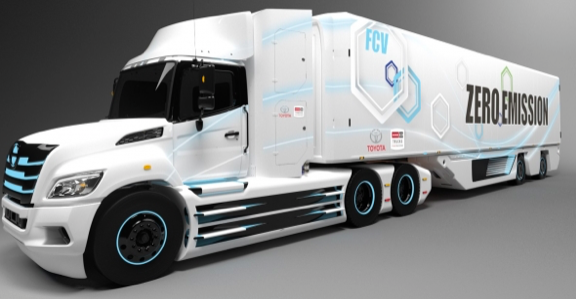
Interest in fuel cells as a power source for heavy duty vehicles continues to grow around the world.
Customers in Switzerland have taken delivery of the first 7 XCIENT Fuel Cell trucks from Hyundai, with a total of 50 due to start work by the end of the year. Cheol Lee, Executive Vice President and Head of Commercial Vehicle Division at Hyundai explained, “The delivery starts a new chapter not only for Hyundai’s hydrogen push, but also the global community’s use of hydrogen as a clean energy source. Today’s delivery is just a beginning as it opens endless possibilities for clean mobility… we proudly announce our plan to expand beyond Europe to North America and China where we are already making great progress.”
Hyundai is aiming to manufacture 2,000 units per year by 2021. It’s spent billions already in the technology as well as investing in the fuelling infrastructure. The company has developed a business model for more than 100 fuelling stations in Switzerland, designed not only for commercial vehicles, but also passenger fuel cell electric vehicles.
The XCIENT is powered by a 190 kW hydrogen fuel cell system with dual 95 kW fuel cell stacks. Storage consists of 7 large hydrogen tanks offering a combined capacity of around 32.09 kg. The range per charge is about 400km, which was developed with an optimal balance between the specific requirements from the potential commercial fleet customers and the charging infrastructure in Switzerland. Refuelling time for each truck takes between 8-20 minutes.
The company is taking a country-by-country approach, for example the North American market will also get a 6x4 tractor model. By 2030, Hyundai expects more than 12,000 fuel cell trucks to hit the US roads.
Speaking of the US, Toyota Motor North America (TMNA) and Hino Trucks have agreed to jointly develop a Class 8 fuel cell electric truck (FCET) specifically for the North American market. The partnership expands an existing effort to develop a 25 ton FCET for the Japanese market which was announced earlier this year. The initial demonstration vehicle is expected to arrive in the first half of 2021. Glenn Ellis, Hino’s Senior Vice President Customer Experience said, “Expanding upon our proud heritage of the Hino powertrain, Toyota fuel cell technology offers our customers a commercially viable, extended range, zero emissions vehicle in the near term. Hino shares a common focus with Toyota when it comes to durability, reliability, and innovation with the customer at the centre of design which makes this collaboration a game changer.”
What about fuel cell buses?
Cummins and Bustech, Australia’s largest supplier of transit buses designed, engineered and built in Australia have teamed up to develop the new XDi low floor transit bus with the former’s zero-emission battery electric and hydrogen fuel cell technologies. Gregg Dinning, chief technology officer of Bustech noted, “Cummins shares our philosophy of building a vehicle platform to ease the transition to zero emission vehicles. An operator can select the best energy solution for a route, taking advantage of the unique properties of the battery and hydrogen powered vehicles. The updated XDi architecture simplifies mixed fleet vehicle maintenance through the quantity of shared components. Leveraging Cummins knowledge of zero-emissions technology and powertrain operation in Australia enables Bustech to deliver a vehicle that is optimised for Australian conditions from conception.”
They are aiming for a 450-600km range based on various on-board hydrogen storage options.
• Read about alternative power sources for heavy duty mining vehicles here.










